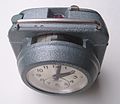Clock
Noting clock or noting apparatus (lat. Constat: "it is fixed") is a special clock that is used in the pigeon sport to record the arrival times of the pigeons returning from a race in a manipulation-proof manner (to “determine”).
functionality
The clock consists of a mechanical or quartz-powered clockwork , a " striking mechanism " that stamps the arrival times on a strip of paper, and a "clocking drum" with up to 30 compartments to hold the rubber rings that the pigeons put on before the race and their numbers the ring numbers the foot rings, with which each carrier pigeon is individually identified, were assigned.
When a pigeon arrives, the rubber ring that has been brought is removed from it and thrown into the sealed clock through the "opening". In the case of older clock models, the rubber ring had to be inserted into a "clock sleeve" beforehand. The compartment with the inserted rubber ring is closed by turning the "detection key", the drum is turned further, the next compartment of the detection drum is opened and the striking mechanism is triggered, which records the time of the "discount" on a strip of paper to the second.
historical development
For more than 100 years, from approx. 1890 to 1993, the Friedrich Ernst Benzing company in Schwenningen was the market leader in the manufacture of mechanical pigeon clocking watches and thus influenced the spread of pigeon racing all over the world. Since 1993, conventional clocking clocks have been increasingly replaced by electronic clocking systems in which the footring numbers and arrival times are recorded using chip rings and sensor antennas.





